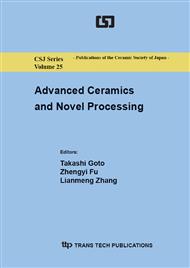[1]
H. Masuda, H. Yamada, M. Satoh, H. Asoh, M. Nakao, T. Tamamura, Highly ordered nanochannel-array architecture in anodic alumina, Appl. Phys. Lett. 71 (1997) 2770.
DOI: 10.1063/1.120128
Google Scholar
[2]
A. Aladjem, Anodic oxidation of titanium and its alloys, J. Mater. Sci. 8 (1973) 688–704.
DOI: 10.1007/bf00561225
Google Scholar
[3]
C. Liang, K. Terabe, T. Hasegawa, M. Aono, Resistance switching in anodic oxidized amorphous TiO2 films, Appl. Phys. Express 1 (2008) 064002.
DOI: 10.1143/apex.1.064002
Google Scholar
[4]
K. Konishi, T. Kubo, A. Nakahira, Characterization and some properties of TiO2 on Ti surface by anodization in acid solution, pp.390-394, Water, Steam and Aqueous Solutions for Electric Power, Advances in Sci. and Tech., Maruzen, 2005.
Google Scholar
[5]
A. Nakahira, K. Konishi, K. Yokota, T. Honma, H. Aritani, K. Tanaka, Synthesis and characterization of TiO2 doped with P ions by anodic oxidation of titanium in acid solution, J. Ceram. Soc. Japan 114 (2006) 46–50.
DOI: 10.2109/jcersj.114.46
Google Scholar
[6]
A. Nakahira, K. Yokota, T. Kubo, Preparation of Ti with nanoholed TiO2 layer by anodic oxidation for medical applications, Advances in Technology of Materials and Materials Processing Journal (ATM) 9 (2007) 41–44.
Google Scholar
[7]
A. Nakahira, K. Yokota, T. Kubo, M. Takahashi, Synthesis and Characterization of TiO2 doped with S ions by anodic oxidation of titanium in acid solution, Chem. Lett. 11 (2007) 1318–1319.
DOI: 10.1246/cl.2007.1318
Google Scholar
[8]
A. Nakahira, K. Yokota, S. Kato, N. Hirota, H. Okada, H. Onodera, Synthesis and Characterization of Fe Nanofiber using Alumina with Nanoholes by Anodic Oxidation, J. Ceram. Soc. Japan 115 (2007) 905–908.
DOI: 10.2109/jcersj2.115.905
Google Scholar
[9]
A. Nakahira, K. Konishi, K. Yokota, T. Kubo, Y. Sasaki, Y. Ikuhara, Synthesis of Novel Structured TiO2 with Mesopores by Anodic Oxidation, Inorg. Chem. 49 (2010) 47–51.
DOI: 10.1021/ic9010136
Google Scholar
[10]
R. Asahi, T. Morikawa, T. Ohwaki, K. Aoki, Y. Taga, Visible-light photocatalysis in nitrogen-doped titanium oxides, Science 293 (2001) 269–271.
DOI: 10.1126/science.1061051
Google Scholar
[11]
N.C. Saha, H.C. Tomkins, Titanium nitride oxidation chemistry: an X-ray photoelectron spectroscopy study, J. Appl. Phys. 72 (1992) 3072–3079.
DOI: 10.1063/1.351465
Google Scholar
[12]
X. Chen, C. Burda, Photoelectron spectroscopic investigation of nitrogen-doped titania nanoparticles, J. Phys. Chem. B 108 (2004) 15446–15449.
DOI: 10.1021/jp0469160
Google Scholar
[13]
H. Tokudome, M. Miyauchi, N-doped TiO2 nanotube with visible light activity, Chem. Lett. 33 (2004) 1108–1109.
DOI: 10.1246/cl.2004.1108
Google Scholar
[14]
T Ohno, M. Akiyoshi, T. Umebayashi, K. Asai, T. Mitsui, M. Matsumura, TiO2 preparation of S-doped TiO2 photocatalysts and their photocatalytic activities under visible light, Applied Catalysis A General 265 (2004) 115–121.
DOI: 10.1016/j.apcata.2004.01.007
Google Scholar
[15]
Y.W. Sakai, K. Obata, K. Hashimoto, H. Irie, Enhancement of visible light-induced hydrophilicity on nitrogen and sulfur-codoped TiO2 thin films, Vacuum 83 (2009) 683–687.
DOI: 10.1016/j.vacuum.2008.04.022
Google Scholar


